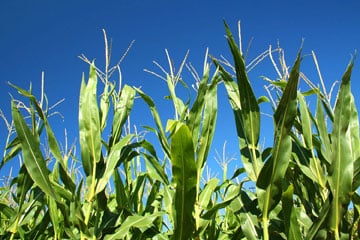EarthTalk®
E – The Environmental Magazine
Dear EarthTalk: What are “agrofuels” and why are organizations like Friends of the Earth campaigning against them? — Bill Wilson, Boise, ID
Agrofuels, also known as biofuels (e.g., ethanol, biodiesel), are fuels derived from plants instead of from oil or other fossil fuels. What makes them appealing to environmentalists and others, at least in theory, is the fact that they can be a carbon-neutral energy source.
Plants take in and store carbon dioxide (CO2) during the process of photosynthesis. When plants die, whether through natural causes or when humans harvest them, this stored CO2 is released back into the atmosphere in an age-old cycle that doesn’t contribute any additional greenhouse gas into the system. But when we extract and burn oil and other fossil fuels, we are taking CO2 that would have otherwise remained locked up deep below the Earth’s surface and releasing it into the atmosphere, essentially overloading the planet’s carbon balance and leading to more global warming.
But as things stand today, the overall process of producing agrofuels is far from carbon neutral, given the fossil fuels expended in growing, harvesting and processing the crops (petroleum-based fertilizers and pesticides, diesel fuel to run tractors, etc…) and then distributing them (via carbon-spewing trucks, trains, ships and airplanes). Of course, growing such crops organically and processing and distributing them without fossil fuels would help close the gap between today’s reality and the dream of carbon-neutrality.
Another major hurdle for agrofuels is the fact that harvesting crops across millions of acres for fuel instead of for food would leave many hungry mouths to feed in the U.S. and elsewhere. Researchers are hoping to overcome this conundrum by generating agrofuels from less land- and input-intensive “crops” such as switchgrass, sugarcane, wood waste or even algae. The latter “feedstock” is especially promising because it can be grown in non-traditional agricultural settings including indoor labs and even on off-shore ocean platforms. But regardless of the wow factor, producing small quantities of fuel from such experimental crops costs hundreds times more than getting oil to gas pumps, so researchers have a long way to go before agrofuels made from these nouveau source crops can make inroads into the mainstream.
Given the issues with producing agrofuels domestically, suppliers are increasingly looking to source them abroad, essentially trading one set of foreign fuel producers for another. But according to Friends of the Earth International (FOEI), “Land grabbing by large companies and agro-businesses to the detriment of local livelihoods, forests and other ecosystems, with gross violations of human rights, have been witnessed in many countries where agrofuels are produced.” FOEI adds: “The production of agrofuels…is generating serious environmental damage and eroding the people’s ability to control the production, trade and consumption of food, given that more and more agricultural land is being devoted for energy crops.”
As recently as five years ago environmentalists were hailing agrofuels as a viable alternative to fossil fuels in the face of increased global warming and skyrocketing oil prices. But as the agrofuels industry starts to grow up, many are wondering whether or not pursuing such a baggage-laden alternative is really worth the trouble, especially in light of more promising developments in other sectors of the renewable fuels sector.
CONTACT: Friends of the Earth International, www.foei.org.
EarthTalk® is written and edited by Roddy Scheer and Doug Moss and is a registered trademark of E – The Environmental Magazine (www.emagazine.com). Send questions to: [email protected]. Subscribe: www.emagazine.com/subscribe. Free Trial Issue: www.emagazine.com/trial.








